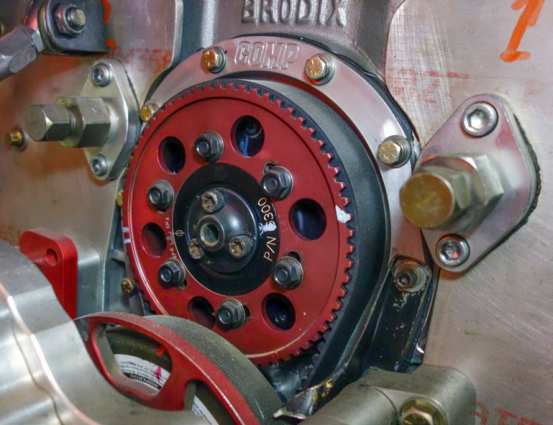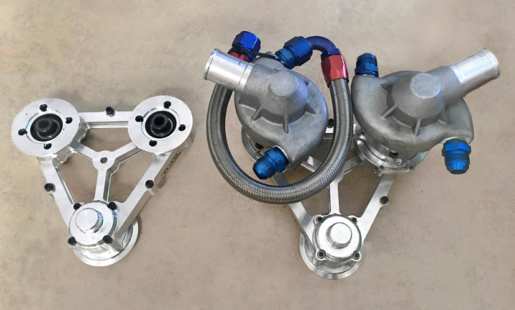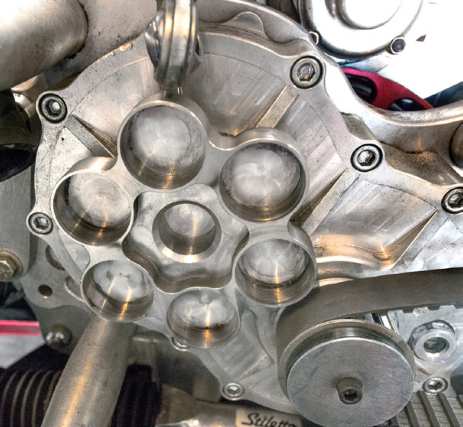PROCHARGER: LAND SPEED / TOP SPEED SETUP

Try to keep a 1,900-hosepower ProCharged big-block Chevy running cool for a five-mile run at Bonneville at speeds exceeding 250 mph. The Big Red crew accepted this challenge by removing the radiator and installing a 55-gallon water tank in the trunk for weight balance and improved traction. There’s not a lot of traction to be had on the salt at Bonneville or on the dry lake bed at El Mirage, but the asphalt at events like Mojave and Texas Mile are a different story. No matter what the driving surface, the Big Red team is going to do its best to conquer it. Their biggest hurdle was cooling the engine when running the five-mile course on the Bonneville salt. The 1.5-mile runs at Mojave are not even close to the extremes at Bonneville.
From the experience at Bonneville, Dave knew the electric pumps in the back of the car were not enough to keep The Elephant cool. He wanted to have water pumping into the back as well as the front of the block, so a conventional water pump wasn’t going to do the job. Whatever water pump Dave installed, it had to fit with the ProCharger drive system. Dave knew about the RCD Engineering
camshaft-driven tri-drive setup, and was familiar with KSE Racing water pumps. The tri-drive is using driving magnetos and fuel pumps off the camshaft, so Dave had the idea to run two mechanical pumpson the tri-drive.
With some machining and fabrication, Dave mounted two water pumps in a way RCD Engineering never intended. Dave now was able to pull water from the rear (assisting the electric pumps) and pump water into the front of the block where the water pump typically mounts with -8 AN fittings. Then he routed -12 AN hoses to the rearmost freeze plugs in the sides of the block. He even crossed the hoses, so the left water pump feeds the engine block in the right front and left rear. The pump on the right does the reverse. This way, if a pump failed, both sides of the block would get a little cooling. When RJ had Larry build the 1,108-horsepower “Monster” 598 big block with the tunnel ram, it was a solid power upgrade from its


predecessor, the 990-horsepower Bullet 598. When the Monster didn’t propel the car fast enough, RJ bit the bullet and made the choice to go with forced induction.
The guys came up with an F-3A-121 ProCharger supercharger, which is driven by a Component Drive Systems (CDS) adapter. The setup puts
additional weight in the nose, but since the engine has 10 inches of setback, it fit in front of the engine without modifying the chassis. Typically, the boost on a supercharger is adjusted by changing the pulley sizes. The CDS uses a pair of quick-change rearend gears to drive the ProCharger. By pulling the unit out of the car and opening the drive case, the gears can be swapped with different gear sets. Big Red has eight sets of gears that spin the ProCharger as slow as 54,000 rpm at peak engine output, and up to to 64,000 rpm. The F-3A is rated up to 72,000 rpm. The higher the rpm, the more boost it makes. The system is driven from the front of the crankshaft/damper. For smooth operation, the CDS utilizes a six-puck polyurethane coupler between the CDS and the ProCharger. Dave says it’s about a one-hour job to remove the supercharger from Big Red, swap the gears, and reinstall everything. Since the addition of the supercharger, Big Red has set more speed records than it would have earned running naturally aspirated.